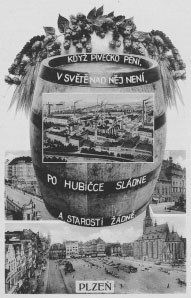Czech Republic, as home to the pilsner style of beer, is a country that can reasonably claim to be the most important in modern beer history. The Czech lands have had a complicated history, including settlement by the Celts, incursion by the Slavs, invasion by the Magyars, folding into the Holy Roman Empire, attachment to the German-speaking Habsburg monarchy, combination into the state of Czechoslovakia, decades as part of the communist Eastern bloc, and reemergence as part of the West.
Throughout all of this, the Czechs have been steady brewers, making good use of excellent Moravian barley and Bohemian hops. Throughout the Middle Ages, the general populace, from peasants to kings, produced beer within their own households. In 1265, King Přemysl Otakar II founded the town of České Budějovice, known in German as Budweis. The town was granted brewing rights and its burghers quickly grew wealthy selling beer. In 1295, King Wenceslas II of Bohemia founded the town of New Plzeň, shifting the town from a less accessible area several kilometers away. At the confluence of four rivers and a number of important trading routes, this new Plzeň was ready for business. King Wenceslas gave all inhabitants of the town the right to brew and sell beer from their houses, a privilege that throughout Central Europe was generally reserved to noblemen. By the early 1300s, we have records of actual commercial breweries in operation. The Bohemians established guilds and gave beer and brewing a central place in society. In 1588, the Bohemian Tadeas Hajeck printed the world’s first brewing textbook.

Czech postcard, c. 1920. The text, from the poem “Pivečko,” by the Czech poet Josef Václav Sládek, extols beer’s power to mask life’s troubles. pike microbrewery museum, seattle, wa
Czech brewing was advancing quickly, but the progress was not to last. The Thirty Years War, which lasted from 1618 to 1648, brought mass death by both violence and plague to much of Central Europe. Beer quality declined and did not fully recover until the early 19th century saw the establishment of several large Měšťanský pivovary “burgher’s” or “citizen’s” breweries. One of these was eventually renamed Plzensky Prazdroj, meaning “pilsner original source,” or “Pilsner Urquell” in German. Here the young Bavarian brewer Josef Groll, using newly developed golden malts together with bottom- fermenting lager yeast brought in from Munich, brewed the original Pilsner beer.
Unlike East Germany, where beer quality was quite poor during its communist regime, Czechoslovakia continued to produce fine lager beers in the decades after World War II. Today, of the major Czech breweries, only Budvar is state-owned. The majority of beer sold in the Czech Republic is relatively light lager classified as výcepní; these are brewed from original gravities between 8° Plato and 12° Plato and generally have less than 4.5% alcohol by volume (ABV). What most of the rest of the world refers to as Bohemian or Czech pilsner is called světlý ležák (pale lager) in the Czech Republic. These beers have a full gold color and fine flowery aromatics from the local Saaz hops, with most having between 4.5% and 5% ABV. Some full-bodied amber Vienna lagers are found (polotmavý ležák), but dark beers referred to as tmavý or Černý ležák or just Černý pivo (black beer) are more common. These were top-fermented beers until the 1890s, when almost all Czech breweries switched to bottom fermentation. They range from dry and brisk to semisweet and malty. Beers having more than 5.5% ABV are referred to as special Speciální, and these range from the famous dark lager at U Fleků in Prague to stronger beers that are cousins to German doppelbocks. Although rare, top-fermented beers are still seen, including weissbiers, which the Czechs claim originated in Bohemia and then migrated to nearby Bavaria. The occasional top-fermenting porter is found as well.
Today, the Czech Republic produces about a half million tons of malt and grows nearly 7,000 metric tons of hops per year, and the country is home to about 125 breweries. The country exports about 3.5 million hl (3 million US bbl) of beer annually, including the famous Pilsner Urquell and Budweiser Budvar, alongside well-known brands such as Staropramen, Krušovice, and Radegast.
Although Czech beers are generally well brewed, choice can be limited. The modern craft brewing movement has been slow to take hold in the Czech Republic, but there are notable signs of a coming flowering of creativity. The number of craft breweries is steadily increasing, influenced by brewing traditions both within and beyond Czech borders. This is helped along by the fact that more bars are willing to try a čtvrtá pípa, or “fourth pipe,” referring to a tap at the bar that is independent of any obligations to larger breweries. Specialty beer bars like Prague’s Pivovarský klub are popping up around the country, carrying extensive beer lists, and sometimes even vegetarian food—a sure sign of change among the meat-loving Czechs.
Czech Beer and Malt Association. Report on the Czech brewing and malting industries. http://www.cspas.cz/ (accessed February 11, 2011).
